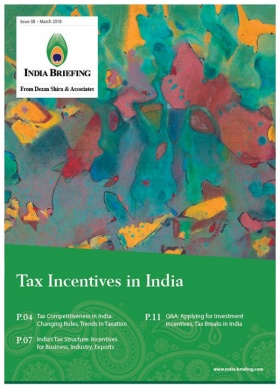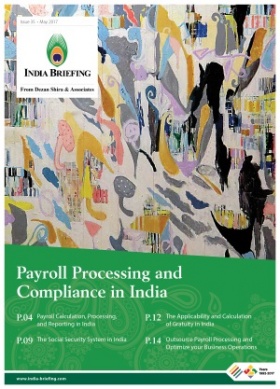Logistics Industry in India – Modernizing with Tax Reform, Technology, and Infrastructure
India’s logistics industry is currently experiencing a transformative phase. The expanding manufacturing base under the federal government’s Make in India initiative, the entry of global players in the logistics industry, along with the introduction of the Goods and Services Tax (GST), and emerging avenues such as e-commerce and logistics parks infrastructure are changing the course and dynamics of the industry.
In this article, we examine the state of India’s logistics sector, assess the enduring challenges as well as the role played by key factors in reshaping the industry.
Logistics industry in India
The logistics sector in India primarily comprises of freight and transportation via road, rail, air, and water, as well as ancillary sectors such as inventory stocks and warehousing.
However, road transport dominates the industry, constituting about 60 percent of the total freight traffic.
As per the Economic Survey 2017-18, India’s logistics market is expected to reach Rs 215 billion (US$300 million) by 2020. India is currently ranked 35th in the World Bank’s Logistics Performance Index (LPI) – which underlines the relatively low efficiency of trade logistics in India, compared to other countries.
Challenges facing India’s logistics
Poor infrastructure: India’s infrastructure development has not kept pace with the growth of business in the country. Businesses involved in logistics continue to suffer from poor road connectivity, inadequate air and seaport capacities, and a lack of development of other modes of transports.
Regulatory hurdles: Though massive government-led infrastructural projects such as dedicated freight corridors and logistics parks are already at work, challenges in the form of red-tapism/bureaucratic hurdles, land acquisition problems, poor funding, environmental compliance, and policy disconnect between the federal and state governments remain.
Unorganized and scattered industry: More than 75 percent of the logistics industry is unorganized. Organized operators face unfair competition from a network of small, multi-level intermediaries who flout rules and regulations, avoid taxes, and thrive on the differential prices that prevail across states.
High logistics costs: India incurs one of the highest logistics costs as a percentage of GDP in comparison to developed countries like the U.S. and Germany – where it is only 8 percent to 9 percent. A joint study by ASSOCHAM-Resurgent India (2016) states that the country can save US$50 billion if the costs of logistics reduced from 14 percent to 9 percent of GDP.
GST – A game changer for India’s logistics
High logistics costs in India are, in part, a result of the previous differential tax regime that promoted the establishment of smaller and multiple warehouses across the country.
Under the pre-GST system, companies built and managed multiple warehouses in every state of business operation – to avoid cross-border tax. This made supply chains longer, costlier, and highly inefficient, resulting in the formation of a highly scattered and unorganized logistics sector.
India’s biggest tax reform – the GST – introduced on July 1, 2017, is set to change this.
As a single, uniform tax – the GST has reduced price differences between states and made tax liabilities uniform across India.
Since there is no tax arbitrage to be gained, companies – under the new tax structure – are free to make decisions on supply chain management solely based on operational efficiency.
Instead of having multiple warehouses in every state to avoid inter-state taxes, companies can opt for a more efficient ‘hub and spoke model’ – wherein there are a few large warehouses connected to manufacturing plants, retail, and wholesale units via an efficient transportation system.
The consolidation of warehouses secures a streamlined supply chain, better planning and optimization, efficient inventory management, less tied-up capital, reduced overhead costs, and increased operational efficiencies for businesses.
Further, the GST system, through its provision of the e-way bill has brought down check-posts at state borders, enabling faster and seamless movement of goods between states.
India’s modernizing logistics infrastructure
Logistics is an integral part of a company’s strategic business plan and operations. It is used to plan and coordinate the movement of products timely, safely, and effectively.
Recognizing the importance of infrastructure for doing business, the federal government is invested in critical initiatives to help companies leverage their economies of scale and provide integrated logistics networks that are cost effective.
These are as follows:
Dedicated freight corridors: The government has notified five major industrial corridors – Delhi-Mumbai Industrial Corridor (DMIC), Amritsar-Kolkata Industrial Corridor (AKIC), Chennai-Bengaluru Industrial Corridor (CBIC), Visakhapatnam-Chennai Industrial Corridor (VCIC) and Bengaluru- Mumbai Economic Corridor (BMEC), for the faster movement of freight. These corridors are spread across 15 states in India.
Logistics parks: These parks serve as centers for freight aggregation and distribution hubs, storage, warehousing, and multi-modal transportation. The government has announced the development of 35 such parks to cut transportation cost and enable swifter freight movement on higher sized trucks and rails between hubs.
Sagarmala: The Sagarmala project aims at doubling the share of seaways in the transport mix over the next decade by executing multiple projects related to the expansion and modernization of various ports.
Technology upgrades: New technology such as the internet of things or IoT, mobile applications, cloud storage, big data analytics, and computing are increasingly being used by startups and logistics companies to improve the existing business operations, transact with new customers and expand their network. Startups like Rivigo are using IoT for real time data collection of truck’s fuel, engine oil temperature, brake oil pressure and more, to improve services and increase transparency in India’s truck industry.
The federal government has also adopted new systems to overcome long-standing logistics challenges. These include: Geographical Information Systems (GIS) based National Highways Information System to overcome the traffic and transportation problems on road; Rake Management System (RMS) for handling commercial transactions on Indian railways; Implementation of Radio Frequency Identification (RFI) for identifying the movement of ships wirelessly using radio waves; and the GST Network – a technology platform at the heart of the GST’s administration – to simplify the taxation system of the logistics companies.
Editor’s Note: The article was first published on August 30, 2017, and has been updated on December 13, 2018 as per the latest developments.
About Us
India Briefing is produced by Dezan Shira & Associates. The firm assists foreign investors throughout Asia and maintains offices in China, Hong Kong, Indonesia, Singapore, Vietnam, and Russia.
Please contact india@dezshira.com or visit our website at www.dezshira.com.
- Previous Article Indian Banks Look to Solve Russian Banking Sanctions Imposed by the US
- Next Article Where to Invest in India – New Issue of India Briefing Magazine Out Now














